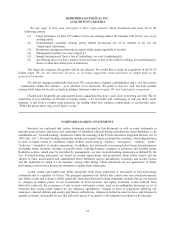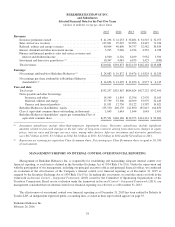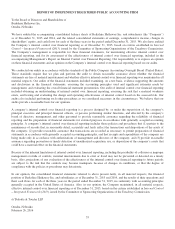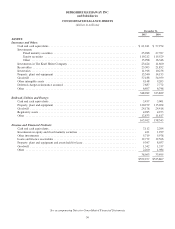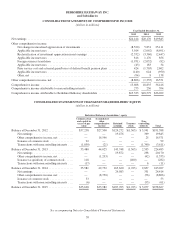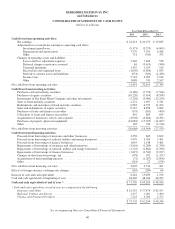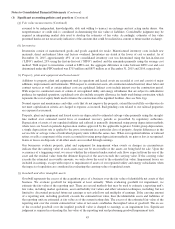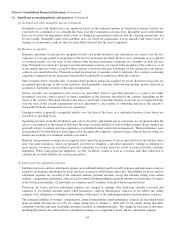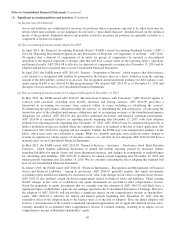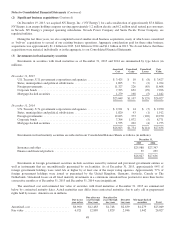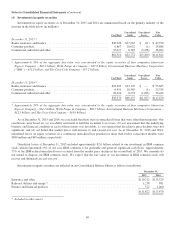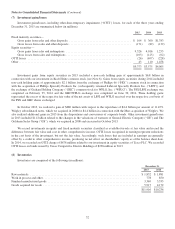Berkshire Hathaway 2015 Annual Report Download - page 44
Download and view the complete annual report
Please find page 44 of the 2015 Berkshire Hathaway annual report below. You can navigate through the pages in the report by either clicking on the pages listed below, or by using the keyword search tool below to find specific information within the annual report.Notes to Consolidated Financial Statements (Continued)
(1) Significant accounting policies and practices (Continued)
(d) Investments (Continued)
Investment gains and losses arise when investments are sold (as determined on a specific identification basis) or are
other-than-temporarily impaired. If a decline in the value of an investment below cost is deemed other than temporary,
the cost of the investment is written down to fair value, with a corresponding charge to earnings. Factors considered in
determining whether an impairment is other than temporary include: the financial condition, business prospects and
creditworthiness of the issuer, the relative amount of the decline, our ability and intent to hold the investment until the
fair value recovers and the length of time that fair value has been less than cost. With respect to an investment in a
fixed maturity security, we recognize an other-than-temporary impairment if we (a) intend to sell or expect to be
required to sell the security before its amortized cost is recovered or (b) do not expect to ultimately recover the
amortized cost basis even if we do not intend to sell the security. Under scenario (a), we recognize losses in earnings
and under scenario (b), we recognize the credit loss component in earnings and the difference between fair value and
the amortized cost basis net of the credit loss in other comprehensive income.
(e) Receivables, loans and finance receivables
Receivables of the insurance and other businesses are stated net of estimated allowances for uncollectible balances.
Allowances for uncollectible balances are provided when it is probable counterparties or customers will be unable to
pay all amounts due based on the contractual terms. Receivables are generally written off against allowances after all
reasonable collection efforts are exhausted.
Loans and finance receivables of the finance and financial products businesses are predominantly manufactured housing
installment loans. Loans and finance receivables are stated at amortized cost based on our ability and intent to hold such
loans and receivables to maturity and are stated net of allowances for uncollectible accounts. The carrying value of
acquired loans represents acquisition costs, plus or minus origination and commitment costs paid or fees received, which
together with acquisition premiums or discounts, are deferred and amortized as yield adjustments over the life of the
loans. Substantially all of these loans are secured by real or personal property or other assets of the borrower.
Allowances for credit losses from manufactured housing loans include estimates of losses on loans currently in
foreclosure and losses on loans not currently in foreclosure. Estimates of losses on loans in foreclosure are based on
historical experience and collateral recovery rates. Estimates of losses on loans not currently in foreclosure consider
historical default rates, collateral recovery rates and prevailing economic conditions. Allowances for credit losses also
incorporate the historical average time elapsed from the last payment until foreclosure.
Loans in which payments are delinquent (with no grace period) are considered past due. Loans which are over 90 days
past due or are in foreclosure are placed on nonaccrual status and interest previously accrued but not collected is
reversed. Subsequent amounts received on the loans are first applied to the principal and interest owed for the most
delinquent amount. Interest income accruals are resumed once a loan is less than 90 days delinquent.
Loans in the foreclosure process are considered non-performing. Once a loan is in foreclosure, interest income is not
recognized unless the foreclosure is cured or the loan is modified. Once a modification is complete, interest income is
recognized based on the terms of the new loan. Loans that have gone through foreclosure are charged off when the
collateral is sold. Loans not in foreclosure are evaluated for charge off based on individual circumstances concerning
the future collectability of the loan and the condition of the collateral securing the loan.
(f) Derivatives
We carry derivative contracts in our Consolidated Balance Sheets at fair value, net of reductions permitted under
master netting agreements with counterparties. The changes in fair value of derivative contracts that do not qualify as
hedging instruments for financial reporting purposes are recorded in earnings or by our regulated utilities businesses as
regulatory assets or liabilities when recovery through regulated rates is probable.
(g) Fair value measurements
As defined under GAAP, fair value is the price that would be received to sell an asset or paid to transfer a liability between
market participants in the principal market or in the most advantageous market when no principal market exists.
Adjustments to transaction prices or quoted market prices may be required in illiquid or disorderly markets in order to
estimate fair value. Alternative valuation techniques may be appropriate under the circumstances to determine the value
that would be received to sell an asset or paid to transfer a liability in an orderly transaction. Market participants are
42


